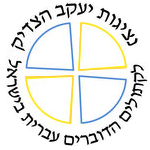Sister Maroussia NDS
Sister Maroussia, nds (Our Lady of Sion) was born on June 20, 1917 in Roussé, in Bulgaria.

Her mother was Russian Orthodox and of Ukrainian origin and her father was Belgian. Marie Legrain, as she was known before her entry into religious life, had six sisters and one brother. A very gifted child, she completed her studies at the Sisters of Sion school in Roussé. At a very young age, she received the call to religious life. She arrived in France and entered the novitiate of the Sisters of Sion in 1939 and took her vows on September 8, 1941. She was sent to the school of the Sisters in Paris where she taught German and especially music, and she studied musicology at the same time. Endowed with the soul of an artist, she had a beautiful, warm voice and she directed with great mastery choirs.
It was in 1961 that Sister Maroussia was called to Jerusalem, to the Convent of Our Lady of Sion in Ein Karem. It was here that the new born community of Hebrew speaking Catholics met. Having a few years earlier received permission from Rome to celebrate the mass in Hebrew, the community had begun to develop its proper liturgical traditions. The community appealed to Maroussia for help in setting the newly translated Hebrew mass to music as well as to compose music for certain Palms and other liturgical chants, especially those of the Triduum (the three days of the celebration of the Easter mysteries). Simultaneously, she undertook studies at the Hebrew University in Eastern musicology so as to be able to carry out the tasks entrusted to her.
However, Maroussia was not the only one engaged in this sphere of activity where everything had to be created from scratch. She collaborated for many years with Brother Yohanan Elihai, who preceded her. This collaboration is memorable for all those who knew this period of creativity. “Hand in hand” is how Yohanan describes the work of that epoch, when they put their talents together, composing, correcting each other, complementing each other, stimulating each other and seeking the advice of Jewish friends. Maroussia was invited to speak of this work in interviews to Israeli radio.
It was also she who succeeded Father Jean-Roger in the work of printing, slowly but surely, the liturgical texts that had been translated into Hebrew. This work was done with the technology that existed then, primitive as it was.
In 1972, a community of the “Solitude” (the contemplative branch of the Sisters of Sion) arrived in Ein Karem and asked Maroussia to compose music for the hymns and antiphones of the Liturgy of the Hours. She undertook this enormous project with enthusiasm, working on it until her last years, even when her health was becoming more and more fragile. It was her health that finally forced her to return to France in 1989.
A refined and delicate person, friendly and ever faithful, Maroussia had a strong will and an extraordinary dynamism which allowed her, despite a serious handicap that affected her feet and caused her much suffering, to compose, give music lessons to the children of Ein Karem, teach Hebrew to seminarians and religious and knit clothes for the poor.
Towards the end of her life, she remained serene, radiant and never complained. She always seemed happy, seeking to bring pleasure to all who surrounded her, full of the inner strength of the love of the Lord, who had given direction to her whole life. She went to Him on January 21, 2001.











 The Pope Expresses His Closeness to the Suffering Israelis and Palestinians
The Pope Expresses His Closeness to the Suffering Israelis and Palestinians Cardinal Parolin Visits Israeli Embassy to Holy See
Cardinal Parolin Visits Israeli Embassy to Holy See Bishops of Poland Express Their Solidarity with Israel
Bishops of Poland Express Their Solidarity with Israel Vicar's Call for a Prayer for Peace
Vicar's Call for a Prayer for Peace Mayor of New York City in Jerusalem Meets Religious Leaders
Mayor of New York City in Jerusalem Meets Religious Leaders Israeli President Reaffirms Commitment to Defend Religious Freedom
Israeli President Reaffirms Commitment to Defend Religious Freedom Revealing History: A Fresh Perspective on Catholics and Jews in WW2
Revealing History: A Fresh Perspective on Catholics and Jews in WW2